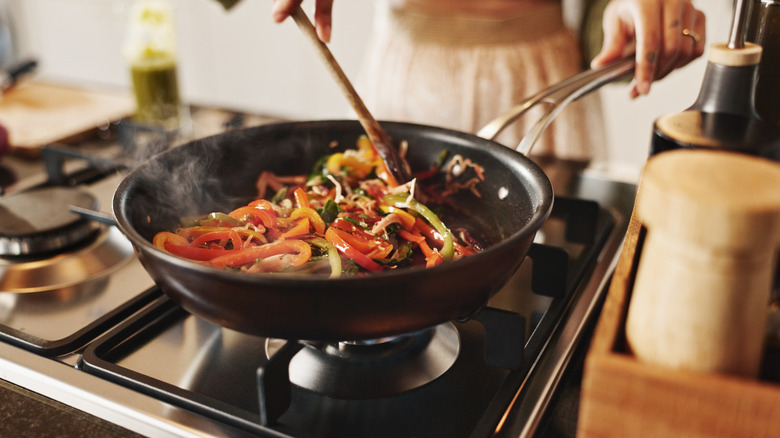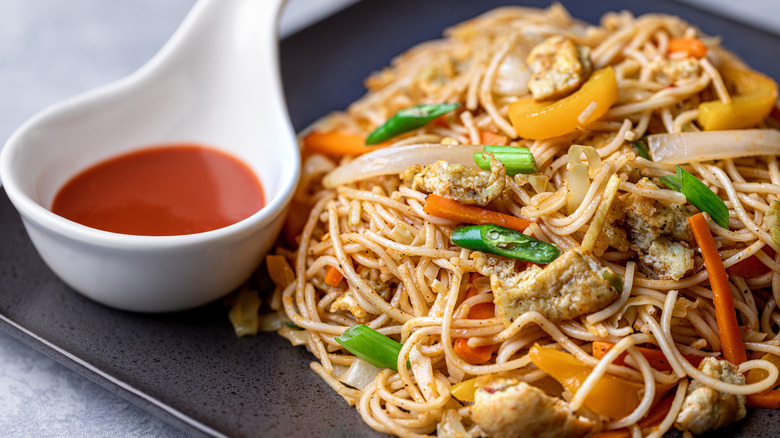The Unexpected Condiment That Works Shockingly Well In A Stir-Fry
It might seem like an all-American staple, but tomato ketchup is found all over the globe — and the classic condiment is especially popular in Asian cooking. If you order the crispy fritters called pakora off an Indian restaurant menu, they may be served with a sauce that combines ketchup with mango chutney, mint, and yogurt. And several must-try global spaghetti dishes like Japanese Naporitan and Hong Kong-style spaghetti include ketchup as a key ingredient. Michael Handal, a chef-instructor at the Institute of Culinary Education, in New York City, suggests this condiment might also have a place in an Asian-style dish you might be cooking at home.
"The addition of ketchup to a stir-fry may serve several purposes," Handal told The Takeout. "Since ketchup has a wonderful balance of sweet and tangy flavors, it may eliminate the need for separate additions of tomato, vinegar, and sugar," he said, explaining that ketchup can add savory as well as sweet notes. It can also help with the consistency of your sauce. According to Handal, "Ketchup's thick texture also helps to act as a coating and thickener in recipes."
How to add ketchup to your stir-fry
The proper time to add ketchup to a stir-fry is right after you fry the onions and garlic, but before you add the soy sauce, sesame oil, or other liquids. "This way, you can very carefully stir-fry the ketchup to the point where the sugars in the ketchup have had a chance to caramelize, but not burn," Michael Handal explained. He compared it to adding tomato paste to a recipe, although he cautioned that ketchup, since it contains more sugar, may burn more easily. If it starts to get too hot, he advised adding the other cooking liquids ASAP to cool things down.
The amount of ketchup you add to a stir-fry will vary depending on how much you're cooking, as well as your personal taste. In Handal's experience, "A good rule of thumb is to start with a few teaspoons by volume, and then judge the color and flavor and go from there." The more ketchup you add, the darker the color of the sauce, and the sweeter and more bold the flavor of your dish will be. Just a little more proof that ketchup belongs on everything.
Other ingredients for your ketchup-y stir-fry
If your stir-fry recipe calls for ketchup, just follow the directions and you're good to go. But what about if you're freestyling with whatever meat and vegetables you have in the fridge? Well, ketchup can still work. As Michael Handal noted, "Many of the ingredients used in Chinese, Asian, and Indian cuisines have a natural affinity to this American staple."
Onions go great with ketchup, as anyone who's eaten a burger can attest, and other aromatics like garlic, scallions, and shallots also play nicely with this condiment. Handal suggested using either fresh or dried chiles, galangal, ginger, or lemongrass, saying they "add a spicy freshness to ketchup," and recommended black pepper, cilantro, cumin, curry leaves, and Thai basil as being ketchup-friendly, too. He also noted that certain liquids will work well in combination with this ingredient, advising, "Soy sauce, rice wine, rice vinegar, dry sherry, Worcestershire sauce, and even fish sauce complement ketchup's distinct flavor profile."
Still, if ketchup is a substitute for another ingredient, it may need a little help. If you're swapping it out for the tamarind paste in pad Thai, Handal cautioned, "The unique flavor aspect of tamarind, which is a very earthy, sweet-tart balance of flavors, is not authentically replicated with the simple substitution of these two ingredients." He added, though, that a splash of vinegar or lime juice could help compensate for the tamarind paste's acidity.


